Enhancing Technology Literacy and Creative Thinking through STEAM-Based Learning: A Comparative Study of Junior High School
Abstract
This study aims to compare the effectiveness of conventional learning and STEAM-based learning in improving technology literacy and creative thinking skills among junior high school students. The STEAM (Science, Technology, Engineering, Art, and Mathematics) approach, integrated through a Project-Based Learning (PjBL) model, offers an interdisciplinary learning experience that directly supports students' critical thinking and technological literacy in line with 21st-century competencies. Using the Research and Development (R&D) method with the ADDIE model (Analysis, Design, Development, Implementation, Evaluation), the research involved 155 eighth- grade students from SMP N 3 Banguntapan. Two classes were randomly selected: one as the experimental group applying the STEAM-based learning device, and the other as the control group with conventional methods. Quantitative data from pretests and posttests showed a significant improvement in the experimental group’s technology literacy (M = 83.96) and creative thinking (M = 73.44) compared to the control group (M = 72.93 and M = 68.62, respectively). These results indicate that the STEAM approach not only enhances conceptual understanding but also fosters active, collaborative, and innovative learning environments. This research supports the integration of STEAM in science education as a strategic response to educational challenges in the digital era
Keywords
Full Text:
PDFReferences
Beers, S. Z. (2011). 21st century skills: Preparing students for THEIR future. Kappa Delta Pi Record, 47(3), 121–123. https://doi.org/10.1080/00228958.2011.10516575
Brown, P., Lauder, H., & Ashton, D. (2011). The global auction: The broken promises of education, jobs, and incomes. Oxford University Press.
Casner-Lotto, J., Barrington, L., & Wright, M. (2006). Are They Really Ready to Work? Employers' Perspectives on The Basic Knowledge and Applied Skills of New Entrants to The 21st-Century U.S. Workforce. The Conference Board.
Darma, Y. (2014). Literasi: Antara teori dan praktik. Pustaka Pelajar.
Devina Nindi Sri Sundari. (2023). Efektivitas model pembelajaran PjBL berbasis STEAM terhadap peningkatan keterampilan berpikir kreatif siswa pada materi bentuk molekul (Skripsi, Universitas Islam Negeri Syarif Hidayatullah Jakarta). Retrieved from http://repository.uinjkt.ac.id
Du, H., Wang, L., & Lei, L. (2019). Literasi teknologi dalam pembentukan kualitas individu dimoderasi oleh transfer pengetahuan untuk peningkatan kinerja individu guru. Jurnal Teknologi Pendidikan, 15(2), 123–135.
Eryansyah, E., Ramadhani, D., & Sari, R. (2019). Peningkatan literasi digital peserta didik: Studi pembelajaran e-learning di SDN 7 Ampenan. Jurnal Pendidikan Dasar, 10(2), 45–56.
Goldin, C. (2015). Human capital. In C. Diebolt & M. Haupert (Eds.), Handbook of cliometrics (pp. 55–86). https://doi.org/10.1007/978-3-642-40458-0_3
Gu, J., Du, H., & Wang, L. (2019). Technology literacy and engineering literacy: A framework for education development. Journal of Educational Research, 32(4), 112–126.
Honey, M., & Hilton, M. (Eds.). (2011). Learning science through computer games and simulations. National Academies Press. https://doi.org/10.17226/13078
Kurnia, N., Astuti, S. I., & Suharno, P. (2019). Urgensi literasi digital bagi anak usia dini dan orang tua. JET: Journal of Education and Technology, 3(1), 11–20.
Lee, H., & Kim, H. (2014). The effects of STEAM-based science learning on the creative problem-solving abilities of students. Journal of the Korean Association for Science Education, 34(2), 135–144. https://doi.org/10.14697/jkase.2014.34.2.135
Lochner, B. (2013). Assessing technology literacy in secondary education: An empirical study on instructional practices. Educational Technology Journal, 15(2), 45–59.
Margot, K. C., & Kettler, T. (2019). Teachers’ perception of STEM integration and education: A systematic literature review. International Journal of STEM Education, 6(1), 2. https://doi.org/10.1186/s40594-018-0151-2
Martin, A. (2008). Digital literacy and the “digital society”. In C. Lankshear & M. Knobel (Eds.), Digital literacies: Concepts, policies and practices (pp. 151–176). Peter Lang.
Muhammad Syahril Harahap, et al. (2021). Pengaruh STEAM terhadap komunikasi matematis siswa. Jurnal Pendidikan Matematika, 19(1), 45–60.
Nabila Salsabila, & Nurjanah. (2023). Pengaruh pendekatan STEAM terhadap kemampuan berpikir kreatif anak usia dini. Jurnal Pendidikan Anak, 12(3), 56–70.
National Assessment Governing Board. (2018). Technology and engineering literacy framework for the 2018 National Assessment of Educational Progress. Retrieved from https://files.eric.ed.gov/fulltext/ED594359.pdf
Nurul Hikmah, et al. (2022). Penggunaan e-modul dan e-LKPD berbasis STEAM dalam pembelajaran sistem koloid. Jurnal Sains & Teknologi Pendidikan, 14(2), 90–110.
OECD. (2018). Preparing our youth for an inclusive and sustainable world: The OECD PISA global competence framework. Retrieved from https://www.oecd.org/education/Global-competency-for-an-inclusive-world.pdf
OECD. (2019). Trends shaping education 2019. OECD Publishing. https://doi.org/10.1787/trends_edu-2019-en
Payton, S., & Hague, C. (2010). Digital literacy in practice: Case studies of primary and secondary classrooms. Futurelab. https://www.nfer.ac.uk/publications/FUTL27/FUTL27.pdf
Pratama, A., & Rahmadani, S. (2019). Profil kemampuan literasi teknologi peserta didik sekolah menengah atas di Kota Bandung. Jurnal Teknologi Literasi Pendidikan, 2(1), 15–25.
Purwanto, E., & Kurniawan, A. (2020). Pengaruh literasi digital terhadap hasil belajar mahasiswa. Jurnal Pendidikan Teknologi Informasi dan Komunikasi, 12(2), 89–98.
RISTEKDIKTI. (2018). Peta jalan revolusi industri 4.0 Indonesia. Kementerian Riset, Teknologi, dan Pendidikan Tinggi.
Rose, M. A. (2007). Literasi teknologi: Pemahaman dan aplikasi dalam pembelajaran sains. Science Education Journal, 11(1), 40–50.
Sumarni, W., & Kadarwati, S. (2020). Teacher-centered vs. student-centered learning: Impact on technology literacy in high schools. International Journal of Educational Studies, 28(3), 89–105.
Syifaurrahmadania, et al. (2024). Modul interaktif berbasis STEAM dan literasi matematis siswa. Jurnal Teknologi Pendidikan, 29(1), 78–92.
Tampubolon, D. (2017). Tantangan literasi digital di Indonesia. Jurnal Komunikasi Indonesia, 5(1), 12–20.
Wijaya, T. T., et al. (2015). Project-based learning for technology literacy enhancement: A comparative study. Journal of Science Education and Technology, 23(1), 74–89. https://doi.org/10.1007/s10956-014-9521-0
Yakman, G., & Lee, H. (2012). Exploring the exemplary STEAM education in the U.S. as a practical educational framework for Korea. Journal of the Korean Association for Science Education, 32(6), 1072–1086. https://doi.org/10.14697/jkase.2012.32.6.1072Refbacks
- There are currently no refbacks.

.png)










